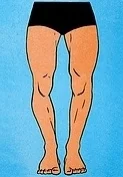Strategies for Bow Legs and Internal Rotation of the Femur
Postural Bow Legs: Internal rotation of the femurs, hyperextension of the knees, pronation of the ankle
Like knock knees, there are 2 main types of "bow legs." One is s Structural Bow Legs, where the femurs are not rotated, but are actually curved outward. In these cases, the knees will point straight ahead but will have space in between them when the knee is extended.
Let's talk about Postural Bow Legs, which are defined by Kendall as a combination of hyperextension of the knees, medial rotation of the femurs and pronation of the ankle. Since the femur is turned in, when the knee flexes and extends it does so at an oblique angle. When that knee is then hyperextended, the knees "bow" away from each other.
In my experience, people with this situation are usually hypermoblie, and are "hanging" on their joints. Often their hips are hyperextended as well.
Strategies to correct Postural Bow Legs
1. Lengthen the adductors, if tight. The adductors are the internal rotators of the hip.
-Lie in a straddle with your legs against a wall, allowing gravity to open the legs.
- With feet in loops on the Reformer, lie in a straddle and let the resistance pull the legs open.
2. Strengthen the external rotators of the hip.
-Clam is the best exercise for this whether it be on the mat, or with some resistance from the leg spring or theraband.
-Sleeper or side lying footwork are also excellent to strengthen the outer hip muscles.
-Footwork on Reformer with a Theraband around the outside of the thigh.
-Squats with a Theraband around the outisde of the thighs.
-Leg Springs on Reformer or Springboard/Cadillac in parallel. keeping knees soft, also work external rotation.
-Side Splits on Reformer with heavy (red) spring.
-Hamstrings on Reformer, working parallel and external rotation.
3. Train the client to not hyperextend their knees.
This is a mental challenge and is difficult to train through muscle strengthening alone. Awareness needs to be brought to standing and walking with a little "sponginess in the knees."
-Toe raises with soft knees. Have client hold onto a bar or a wall for balance, and have them soften their knees, bringing the tibia forward over the ankle joint. Do 10 toe raises not allowing the head to go up and down, but rather the knees to go forward as toes rise up. Then try single leg 10x on each side. After this exercise, have the client walk around. It brings a great awareness to how the lower limb should be aligned over the ankle.
-When doing Footwork on the Reformer (with anyone with hyperextension in the knees), have them stop before they are in their "bony end point". Have them stay in their muscles, not going into full lock out.

